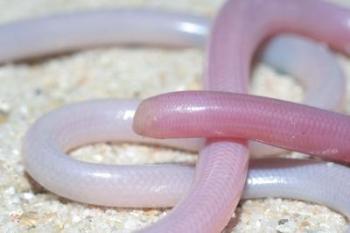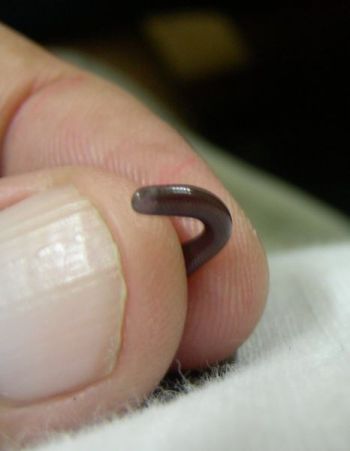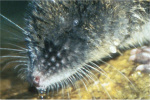World-traveling blindsnake points to Madagascar’s origins and great voyages across the Atlantic.
Call them survivors: blindsnakes have been identified as one of the few groups of organisms that inhabited Madagascar when it broke from the Indian subcontinent around 100 million years ago. According to a new study in Biology Letters, blindsnakes not only survived the split of Madagascar and India, but likely traveled from Asia to Australia and Africa to South America on floating vegetation, the latter a journey that may have taken six months of drifting on ocean currents.
“Blindsnakes are not very pretty, are rarely noticed, and are often mistaken for earthworms,” says Blair Hedges of her subjects. “Nonetheless, they tell a very interesting evolutionary story.”
Hedges, professor of biology at Penn State University, was a lead author of the study, which looked at the evolution of blindsnakes by examining the genetics of 96 blindsnake species of some 260 known species.
Blindsnakes are burrowing worm-like snakes that despite being largely-unknown to the public and long-ignored by scientists, occur on every continent except Antarctica. Feeding on ants and termites, blindsnakes are not actually blind, but simply have poor vision likely due to their underground lifestyle. However, researchers were puzzled by how these underground snakes have popped up in so many locations.
 Blindsnakes look resemble worms. Photo by: Frank Glaw. |
“Our findings show that continental drift had a huge impact on blindsnake evolution,” explains Nicolas Vidal, of the Muséum National d’Histoire Naturelle in Paris and co-author of the study, “by separating populations from each other as continents moved apart.”
According to the research, blindsnakes first evolved on Gondwana, the ancient southern supercontinent. Continental splits beginning around 155 million years ago fractured blindsnakes populations. For example, at one point a landmass broke off of East Gondwana that incorporated both India and Madagascar. Around 94 million years ago, that land mass broke up and Madagascar drifted to its current position off the coast of East Africa while India eventually collided with Asia. Researchers now know that a population of ancient Gondwanan blindsnakes eventually drifted on Madagascar to its present location.
Due to nearly a hundred million years of isolation, Madagascar has evolved some truly bizarre species—such as the long-fingered aye-aye or the lemur-hunting fossa—that live nowhere else. In fact, even 90 percent of Madagascar’s plants are endemic. The blindsnakes that live on Madagascar—after millions of years of independent evolution—are also unique enough for the researchers to have dubbed them their own family.
 Head of a Typhlops blindsnake from India. Photo by: AshLin. |
But this was not the only blindsnake odyssey: blindsnakes made an even more incredible journey tens of millions of years ago. Researchers hypothesize that since genetics show the blindsnakes of Africa and South America split 63 million years ago, and not 100 million years ago when these continents parted, they must have reached South America by hitching a ride on floating flotsam. To date only seven or so other vertebrate species are thought to have reached South America by crossing the Atlantic from east to west. The journey would have taken around six months, but blindsnakes are capable of surviving with little food and it’s likely that the snake would have hunted insects also drifting on the raft.
“Some scientists have argued that oceanic dispersal is an unlikely way for burrowing organisms to become distributed around the world,” observes Hedges. “Our data now reinforce the message that such ‘unlikely’ events nonetheless happened in evolutionary history.”
Eventually, blindsnakes reached their last continent, Australia, around 28 million years ago. Lacking any land route, the researchers believe the blindsnakes made a second oceanic crossing on floating vegetation to reach the southerly continent.
Related articles
Natural rafts carried Madagascar’s unique wildlife to its shores

(01/20/2010) Imagine, forty million years ago a great tropical storm rises up on the eastern coast of Africa. Hundreds of trees are blown over and swept out to sea, but one harbors something special: inside a dry hollow rests a small lemur-like primate. Currents carry this tree and its passenger hundreds of miles until one gray morning it slides onto a faraway, unknown beach. The small mammal crawls out of its hollow and waddles, hungry and thirsty, onto the beach. Within hours, amid nearby tropical forests, it has found the sustenance it needs to survive: in a place that would one day be named Madagascar.
Photos: Madagascar’s wonderful and wild frogs, an interview with Sahonagasy
(03/03/2010) To save Madagascar’s embattled and beautiful amphibians, scientists are turning to the web. A new site built by herpetologists, Sahonagasy, is dedicated to gathering and providing information about Madagascar’s unique amphibians in a bid to save them from the growing threat of extinction. “The past 20 years have seen resources wasted because of a poor coordination of efforts,” explains Miguel Vences, herpetologist and professor at the Technical University of Braunschweig. “Many surveys and reports have been produced that were never published, many tourists found and photographed amphibians but these photos were not made available to mapping projects, many studies carried out by Malagasy students did not make use of literature because it was not available.”
Forgotten species: Madagascar’s water-loving mammal, the aquatic tenrec

(11/12/2009) There are many adjectives one could attach to the aquatic tenrec: rare, mysterious, elusive, one-of-a-kind, even adorable, though one tries to stray from such value-laden titles since it excludes so many other non-adorable inhabitants of the animal kingdom. This small and, yes, cute insectivore, also known as the web-footed tenrec, lives in Eastern Madagascar where at night it spends the majority of its time swimming and diving in fast-moving streams for insects and tadpoles. It sleeps during the day in small streamside burrows. To date that is about the extent of our knowledge of this species.
